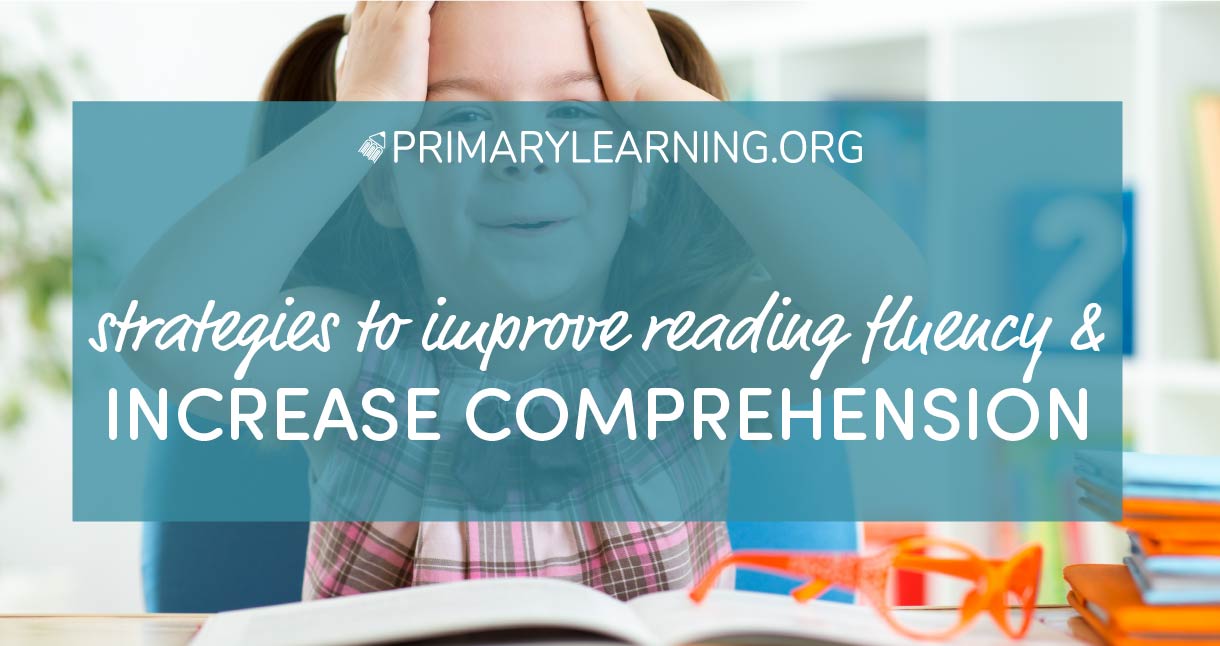

Posted by: Alesia Netuk
Updated: October 2nd, 2023
Strategies to Improve Reading Fluency and Increase Comprehension
Strategies to Improve Reading Fluency and Increase Comprehension
What is Fluency?
Fluency is the rate at which the child reads. Think about the speed: Is the child reading word-by-word? Does it sound choppy and robotic? Are there long pauses between words? Or is it the opposite, and the child is rushing through the words, reading much too quickly? Does he pay attention to punctuation, stopping at periods, and pausing for commas?
Fluency also involves reading with appropriate expression. Fluent readers take note of things like exclamation marks and question marks and adjust their voice. Their expression sounds natural, and their voice is not as flat as they read.
Children who are fluent readers make their reading sound like talking. Their reading sounds effortless, much like carrying on a conversation.
How Can We Improve Fluency?
First, it’s important to choose “just right” books for children to read. They will struggle to read books that are too difficult, spending their time trying to figure out unfamiliar words. This causes fluency to break down. Also, if a child is struggling with fluency, consider having him read books that are easy. When a child doesn’t have to spend energy on decoding words and instead can read the words with ease, this frees up his energy to focus on speed and expression.
Model for children how reading should sound. It’s important to discuss what fluent reading sounds like but even better actually to demonstrate it. Model reading, so children understand what you mean when you ask them to use the expression or string words together more smoothly. Another option is to have children listen to audiobooks to hear what fluent reading sounds like.
Have you heard of toobaloos or “whisper phones?” They are like pretend telephones that children read into. You can buy commercial brand toobaloos or make your own using PVC pipe. When children read into a toobaloo, they can hear themselves well and use that feedback to think about their expression and reading rate. Many children also find using toobaloos fun and motivating to use!
You can encourage fluency by using choral reading. This occurs when a group of children reads something together, saying the words at the same time. You might read the text out loud by yourself first, so the children can hear how the reading should sound. Then you can read it together, with them matching your pace and expression.
Children can improve their fluency by re-reading a short book or for older children, re-reading a certain passage from a story. As they become more familiar with the text, they can focus their attention on reading it fluently. Practicing the same selection will allow them to master becoming a fluent reader.
These worksheets help kids build fluency skills:
Fluency: Roll & Read 3 Letter Blends
With this worksheet, young learners roll and read 3 letter blends words. It has a Summer theme to make phonics practice these days fun and exciting.
Fluency: Roll & Read 3 Letter Blends
Fluency: Roll & Read Digraphs
With this worksheet, young learners roll and read digraphs words. It has a Summer theme to make phonics practice these days fun and exciting.
Fluency: Roll & Read Digraphs
Fluency: Roll & Read Long A Vowel
With this worksheet, young learners roll and read long a vowel words. It has a Summer theme to make phonics practice these days fun and exciting.
Fluency: Roll & Read Long A Vowel
Fluency: Roll & Read Short A
With this worksheet, young learners roll and read short a words. It has a Summer theme to make phonics practice these days fun and exciting.
Fluency: Roll & Read Short A
Sight Word A Fluency
This reading passage focuses on sight word A and great for morning work, literacy centers, homework, and guided reading.
Sight Word A Fluency
Sight Word AND Fluency
This reading passage focuses on sight word AND and great for morning work, literacy centers, homework, and guided reading.
Sight Word AND Fluency
Sight Word THE Fluency
This reading passage focuses on sight word THE and great for morning work, literacy centers, homework, and guided reading.
Sight Word THE Fluency
Sight Word ASK Fluency
This reading passage focuses on sight word ASK and is great for morning work, literacy centers, homework, and guided reading.
Sight Word ASK Fluency
What is Comprehension?
Comprehension is the ability to process and understand what we’re reading. Without comprehension, children are just saying the words and not applying any meaning to them. Think of trying to read a book about a topic you know little to nothing about and have difficulty grasping. You may be able to read the words but would derive very little understanding of the complex topic.
Comprehension may involve making connections between what a child is reading and what he already knows. For example, he may relate a story about a lost toy to a time when he couldn’t find one of his own toys. He may also think about what he knows about taking care of his dog before reading a story about pets.
Another part of comprehension is generating questions or “wonderings” as a child is reading. For example, she may wonder what the main character will do next or wonder how the problem in the story will be solved. Comprehension is about interacting with the story.
These worksheets help kids build solid comprehension skills:
AB Word Family Reading Comprehension
AB word family reading comprehension simple story for kindergarten kids! This worksheet has 6 activities, including reading passage and focuses on words ending -ab.
AB Word Family Reading Comprehension
AG Word Family Reading Comprehension
AG word family reading comprehension simple story for kindergarten kids! This worksheet has 6 activities, including reading passage and focuses on words ending -ag.
AG Word Family Reading Comprehension
AM Word Family Reading Comprehension
AM word family reading comprehension simple story for kindergarten kids! This worksheet has 6 activities, including reading passage and focuses on words ending -am.
AM Word Family Reading Comprehension
AN Word Family Reading Comprehension
AN word family reading comprehension simple story for kindergarten kids! This worksheet has 6 activities, including reading passage and focuses on words ending -an.
AN Word Family Reading Comprehension
AT Word Family Reading Comprehension
AT word family reading comprehension simple story for kindergarten kids! This worksheet has 6 activities, including reading passage and focuses on words ending -at.
AT Word Family Reading Comprehension
UB Word Family Reading Comprehension
UB word family reading comprehension simple story for kindergarten kids! This worksheet has 6 activities, including reading passage and focuses on words ending -ub.
UB Word Family Reading Comprehension
UG Word Family Reading Comprehension
UG word family reading comprehension simple story for kindergarten kids! This worksheet has 6 activities, including reading passage and focuses on words ending -ug.
UG Word Family Reading Comprehension
UN Word Family Reading Comprehension
UN word family reading comprehension simple story for kindergarten kids! This worksheet has 6 activities, including reading passage and focuses on words ending -un.
UN Word Family Reading Comprehension
How Can We Improve Comprehension?
Choose books about topics that children can relate to. Without any prior knowledge about a topic, comprehension becomes more difficult. Before reading, you can discuss the topic together. This may be as simple as saying, “Think about a time when you felt really angry” or asking, “Has your family ever been running late in the morning?” This helps set the stage for the book and gets children thinking about the topic.
Encourage children to make predictions as they read. If you are reading aloud, model this thought process by pausing at points in the book and sharing your thinking. Invite children to make their own predictions. The goal is to get them engaging in books, not just passively reciting the words.
You can also model the questions you come up with as you’re reading. Teach children to take notes of what they’re wondering while they read. Do these wonderings get answered by the end of the book? Another strategy to try during read alouds or when children are reading independently is to pause and check to see if they understand what’s happening.
You can help support comprehension by teaching children how to visualize. Use read alouds that lend themselves to making a picture in their mind. Pause and ask them to close their eyes and think about what they see, hear, smell, taste, or feel during a certain moment in the book.
If a child is struggling with comprehension, chunk the reading into smaller sections, like one page or one paragraph. Then check his understanding after each section. You can also teach children how to summarize information. This can be used for fiction and non-fiction books. Model how to pull out the main points in a story. Use graphic organizers to help children identify the setting, main characters, problem, and solution in a fictitious story. Teach children how to use text features such as headings and sub-headings to help them understand non-fiction books. Consider implementing another reading strategy for struggling readers.
If your child continues to struggle with fluency and comprehension, despite your best efforts, talk to your healthcare or education professionals about your concerns. They may be able to provide you with advice about the next steps in exploring your child’s learning needs.
References
LEARNING MATERIALS TO MEET EVERY CHILD’S NEEDS
Here, at PrimaryLearning.Org, we tend to deliver the best-differentiated learning materials to K-2 students. Our resources can be easily incorporated into multisensory lessons to meet every child’s needs, whether s/he is a visual, kinesthetic, or auditory learner.